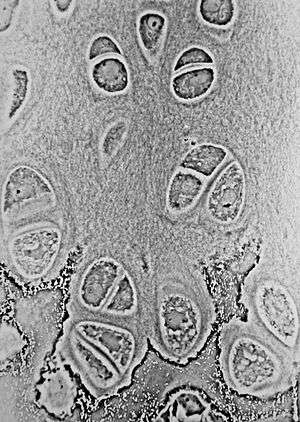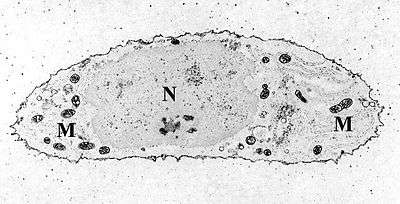Chondrocyte
Chondrocytes (/ˈkɒndrəsaɪt, -droʊ-/,[1] from Greek χόνδρος, chondros = cartilage + κύτος, kytos = cell) are the only cells found in healthy cartilage. They produce and maintain the cartilaginous matrix, which consists mainly of collagen and proteoglycans. Although the word chondroblast is commonly used to describe an immature chondrocyte, the term is imprecise, since the progenitor of chondrocytes (which are mesenchymal stem cells) can differentiate into various cell types, including osteoblasts.
| Chondrocyte | |
|---|---|
 Light micrograph of undecalcified hyaline cartilage showing its chondrocytes and organelles, lacunae and matrix. | |
| Details | |
| Location | Cartilage |
| Function | Produce and maintain cartilage matrix |
| Identifiers | |
| Latin | chondrocytus |
| MeSH | D019902 |
| TH | H2.00.03.5.00003 |
| FMA | 66782 |
| Anatomical terms of microanatomy | |
Development
From least- to terminally-differentiated, the chondrocytic lineage is:
- Colony-forming unit-fibroblast
- Mesenchymal stem cell / marrow stromal cell
- Chondrocyte
- Hypertrophic chondrocyte
Mesenchymal (mesoderm origin) stem cells are undifferentiated, meaning they can differentiate into a variety of generative cells commonly known as osteochondrogenic (or osteogenic, chondrogenic, osteoprogenitor, etc.) cells. When referring to bone, or in this case cartilage, the originally undifferentiated mesenchymal stem cells lose their pluripotency, proliferate and crowd together in a dense aggregate of chondrogenic cells (cartilage) at the location of chondrification. These chondrogenic cells differentiate into so-called chondroblasts, which then synthesize the cartilage extracellular matrix (ECM), consisting of a ground substance (proteoglycans, glycosaminoglycans for low osmotic potential) and fibers. The chondroblast is now a mature chondrocyte that is usually inactive but can still secrete and degrade the matrix, depending on conditions.
BMP4 and FGF2 have been experimentally shown to increase chondrocyte differentiation.[2]
Cell culture studies of excess Vitamin A inhibits the synthesis of chondroitin sulfate by chondrocytes and causes the inhibition of chondrogenesis in the developing embryo which may result in limb malformations.[3]
Chondrocytes undergo terminal differentiation when they become hypertrophic, which happens during endochondral ossification. This last stage is characterized by major phenotypic changes in the cell.
Structure
The chondrocyte in cartilage matrix has rounded or polygonal structure. The exception occurs at tissue boundaries, for example the articular surfaces of joints, in which chondrocytes may be flattened or discoid. Intra-cellular features are characteristic of a synthetically active cell. The cell density of full-thickness, human, adult, femoral condyle cartilage is maintained at 14.5 (±3.0) × 103 cells/ mm2 from age 20 to 30 years. Although chondrocyte senescence occurs with aging, mitotic figures are not seen in normal adult articular cartilage. The structure, density, and synthetic activity of an adult chondrocyte are various according to its position. Flattened cells are oriented parallel to the surface, along with the collagen fibers, in the superficial zone, the region of highest cell density. In the middle zone, chondrocytes are larger and more rounded and display a random distribution, in which the collagen fibers also are more randomly arranged. In the deeper zones, chondrocytes form columns that are oriented perpendicular to the cartilage surface, along with the collagen fibers. Different behaviors may be exhibited by chondrocytes depending on their position within the different layers. In primary chondrocyte cultures, these zonal differences in synthetic properties may persist. The primary cilia are significant for spatial orientation of cells in developing growth plate and are sensory organelles in chondrocytes. Primary cilia work as centers for wingless type (Wnt) and hedgehog signaling and contain mechanosensitive receptors.[4]
Gallery
 Chondrocytes in hyaline cartilage
Chondrocytes in hyaline cartilage Transmission electron micrograph of a chondrocyte, stained for calcium, showing its nucleus (N) and mitochondria (M).
Transmission electron micrograph of a chondrocyte, stained for calcium, showing its nucleus (N) and mitochondria (M).
See also
References
- https://www.lexico.com/en/definition/chondrocyte
- Lee, T. J.; Jang, J.; Kang, S.; Jin, M.; Shin, H.; Kim, D. W.; Kim, B. S. (2013). "Enhancement of osteogenic and chondrogenic differentiation of human embryonic stem cells by mesodermal lineage induction with BMP-4 and FGF2 treatment". Biochemical and Biophysical Research Communications. 430 (2): 793–797. doi:10.1016/j.bbrc.2012.11.067. PMID 23206696.
- Lewis, C.A. (1978). "Inhibition of limb chondrogenesis in vitro by Vitamin A: alterations in cell surface characteristics". Developmental Biology. 64: 31–47.
- Mary B. Goldring et al. "Cartilage and Chondrocytes", in Gary Feinstein et al. Kelley and Firestein’s Textbook of Rheumatology, 10th edition (2017)
- Dominici M, Hofmann T, Horwitz E (2001). "Bone marrow mesenchymal cells: biological properties and clinical applications". J Biol Regul Homeost Agents. 15 (1): 28–37. PMID 11388742.
- Bianco P, Riminucci M, Gronthos S, Robey P (2001). "Bone marrow stromal stem cells: nature, biology, and potential applications". Stem Cells. 19 (3): 180–92. doi:10.1634/stemcells.19-3-180. PMID 11359943.
External links
- Histology image: 03317loa – Histology Learning System at Boston University
- Stem cell information